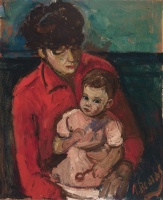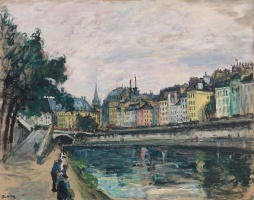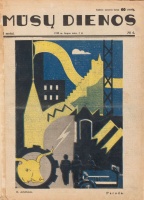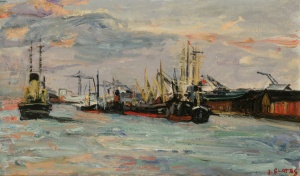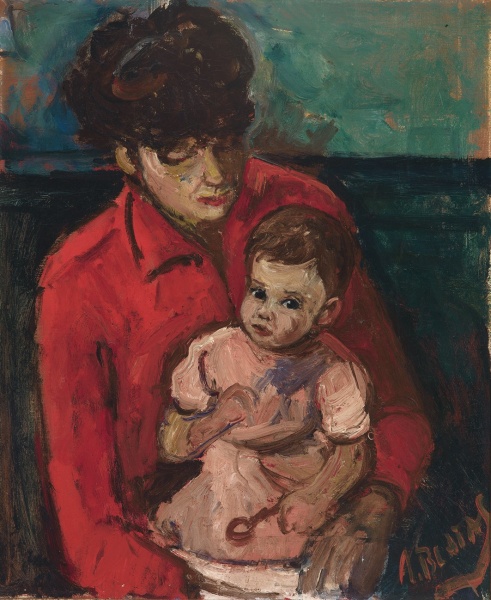

Mother and Child
| Author: | Neemiya Arbitblatas (1908–1999) |
Arbit Blatas (Neemiya Arbitblatas) (b. 1908 Kaunas – d. 1999 New York) was born into a wealthy, liberal but religious family, Arbit Blatas went to study in Germany at the age of 16, but after a couple of years moved to Paris, becoming one of the most prominent members of the École de Paris. There he began to sign his works Arbit Blatas, and later shortened his name to Blatas. While living in Paris in the interwar period, he regularly visited Kaunas, where he founded the Gallery of Modern Art, which had a significant influence on the development of Lithuanian art. After the Second World War, he lived in Paris, Nice and Venice, and later settled in New York. Arbit Blatas painted, sculpted, made works of graphic art, and designed scenery for theatres in Hamburg, Lisbon, Madrid, Strasbourg, Vancouver, Warsaw and Venice. He held several dozen solo exhibitions, and was awarded the Knight’s Cross and the Officer Cross of the French Légion d’honneur, the Masada State Medal of Israel, and other awards.
Source: Ellex Valiunas (LAWIN until 2015) art album: STORIES OF LITVAK ART (2023). Compiler and author Vilma Gradinskaitė.
Arbit Blatas (Blatas, Neemija Arbitblatas, 1908–1999). Arbit Blatas was a painter, sculptor and theatre artist. He was born on 19 November 1908 in Kaunas. From 1924 to 1926 he studied art in Berlin under Kornsans, in Dresden, and in 1926–1932 in Paris (at Julian’s studio, Académie Julian La Grande Chaumière) under André Lhoteandpainted in Normandy. In 1929 he began to participate in exhibitions in the Paris Autumn Salon. In 1926–1927 (together with A. Šimkūnas), and in the years 1929, 1930 and 1933, he heldindividual exhibitions in Kaunas, and in 1934 and 1936 in Paris. In the third and fourth decades of the XX century he was an active participant in Kaunas artistic life and in 1932 he opened his private art salon–gallery. In the fourth decade he painted several portraits of Lithuanian cultural figures (P. Tarulis, S. Binkienė, and the famous film director Juozas Vaičkus). In 1939 he settled in the USA. In 1975 A. Blatas married Regina Resnik, a singer in the New York Metropolitan Opera. He created stage settings and costumes for operas (Carmen, Electra, Salomėja, The Queen of Spades, etc.) and seven bas-reliefs Calamity at the New Ghetto wall in Venice (1993). In 1978 he was awarded the French Order of the Legion of Honour. He died on 27 April 1999 in New York.
Source: Valiunas Ellex (LAWIN until 2015) art album: THE WORLD OF LANDSCAPES II (2013). Compiler and author Nijolė Tumėnienė.

Arbit Blatas (Neemiya Arbitblatas) (b. 1908 Kaunas – d. 1999 New York) was born into a wealthy, liberal but religious family, Arbit Blatas went to study in Germany at the age of 16, but after a couple of years moved to Paris, becoming one of the most prominent members of the École de Paris. There he began to sign his works Arbit Blatas, and later shortened his name to Blatas. While living in Paris in the interwar period, he regularly visited Kaunas, where he founded the Gallery of Modern Art, which had a significant influence on the development of Lithuanian art. After the Second World War, he lived in Paris, Nice and Venice, and later settled in New York. Arbit Blatas painted, sculpted, made works of graphic art, and designed scenery for theatres in Hamburg, Lisbon, Madrid, Strasbourg, Vancouver, Warsaw and Venice. He held several dozen solo exhibitions, and was awarded the Knight’s Cross and the Officer Cross of the French Légion d’honneur, the Masada State Medal of Israel, and other awards.
Source: Ellex Valiunas (LAWIN until 2015) art album: STORIES OF LITVAK ART (2023). Compiler and author Vilma Gradinskaitė.
Arbit Blatas (Blatas, Neemija Arbitblatas, 1908–1999). Arbit Blatas was a painter, sculptor and theatre artist. He was born on 19 November 1908 in Kaunas. From 1924 to 1926 he studied art in Berlin under Kornsans, in Dresden, and in 1926–1932 in Paris (at Julian’s studio, Académie Julian La Grande Chaumière) under André Lhoteandpainted in Normandy. In 1929 he began to participate in exhibitions in the Paris Autumn Salon. In 1926–1927 (together with A. Šimkūnas), and in the years 1929, 1930 and 1933, he heldindividual exhibitions in Kaunas, and in 1934 and 1936 in Paris. In the third and fourth decades of the XX century he was an active participant in Kaunas artistic life and in 1932 he opened his private art salon–gallery. In the fourth decade he painted several portraits of Lithuanian cultural figures (P. Tarulis, S. Binkienė, and the famous film director Juozas Vaičkus). In 1939 he settled in the USA. In 1975 A. Blatas married Regina Resnik, a singer in the New York Metropolitan Opera. He created stage settings and costumes for operas (Carmen, Electra, Salomėja, The Queen of Spades, etc.) and seven bas-reliefs Calamity at the New Ghetto wall in Venice (1993). In 1978 he was awarded the French Order of the Legion of Honour. He died on 27 April 1999 in New York.
Source: Valiunas Ellex (LAWIN until 2015) art album: THE WORLD OF LANDSCAPES II (2013). Compiler and author Nijolė Tumėnienė.






